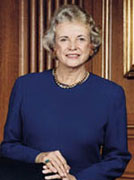Sandra Day O'Connor

Supreme Court Justice
The people of Phoenix, Arizona were indeed proud of one of their own when Sandra Day O'Connor was named to the U.S. Supreme Court. It shouldn't surprise anyone that was involved in some controversial decisions while serving in that position. While not everyone agreed with her opinions and assessments, no one questions her diligence and integrity. Sandra Day O'Connor may not be flamboyant or attention seeking, but she is very powerful and well-respected.
Sandra Day O'Connor was the first woman and the 102nd person to sit on the Supreme Court of the United States. Born in El Paso, Texas in 1930, she spent her early childhood on the sprawling family ranch in Southeastern Arizona. Her parents decided to send her back to El Paso to live with her grandmother when she became of school age. Her grandmother, Mamie Scott Wilkey, is said to have had the greatest influence upon Sandra.
Sandra Day majored in economics at Stanford University and graduated with high honors. She continued her graduate work there. It was during her work as editor on the Stanford Law Review that she met John Jay O'Connor III, also attending law school at Stanford. In 1952 she graduated from law school, again with honors, and soon thereafter was married to John O'Connor. Despite her excellent scholastic record, it was difficult for women to find positions as lawyers. Her husband practiced law for a few years before they decided to build a home in north Phoenix. Their first child, Scott, was born in 1957. Two more sons joined the family in 1960 and 1962. In 1965, Sandra Day O'Connor went to work on a part-time basis for the Arizona attorney general's office. In 1969 she was appointed to the state Senate and was subsequently re-elected to that position. In 1973 Sandra Day O'Connor was the first woman to serve as the majority leader of a state Senate.
In 1974 Sandra Day O'Connor was elected to a position of trial judge for Maricopa County and 5 years later was appointed by then Governor Bruce Babbitt to the Court of Appeals. On July 7, 1981 President Reagan announced that Sandra Day O'Connor was his appointee to fill the vacancy on the Supreme Court left by Associate Justice Potter Stewart's retirement. He was determined to follow through on his commitment to include women in high places of authority and importance. Sandra was a relative unknown, having spent most of her life in the West and having never served in the federal judicial system. Conservatives were not particularly happy with his choice, since she had taken a rather moderate position on abortion in the past. During her appointment hearings, O'Connor would not reveal how she would vote if a repeal of Roe Vs. Wade was put before her, nor would she speculate on any other issues. She was confirmed by a Judiciary Committee vote of 17 to 1 and won approval by the U.S. Senate by a vote of 99 to 0.
Justice O'Connor's first major case came in 1982. In this case about sex discrimination she wrote the opinion that a male student could not be rejected from a nursing school because of his gender. She received the most attention, however, for a case in 1989, Webster vs. Reproductive Health Services which restricted access to abortions in certain cases. Justice O'Connor was the deciding vote. The 5 to 4 decision upheld the law giving states the right to make specific abortion decisions. Conservatives had hoped that her swing vote in this case would lead to further restrictions on abortions and a repeal of the famous Roe Vs. Wade. Justice O'Connor would not go that far, however, and Roe vs. Wade has not been overturned.
During her legal career, Sandra Day O'Connor had a reputation for being cold and humorless. Justice O'Connor was regarded as a consummate compromiser; her goal on issues was simply to achieve a majority vote. She is considered to be tough and is a conservative, but not as tough or conservative when it comes to women's rights and children. O'Connor made it clear that she believes a court's role, including that of the Supreme Court, is to interpret and not to legislate. She has been referred to as the most influential woman in America.
A high school in Glendale, Arizona, just northwest of Phoenix, was named for her. Opened in 2002, The Supreme Court Justice attended the Sandra Day O'Connor High School dedication ceremony.
In July 2005 Sandra Day O'Connor announced that she would retire from her position as a Supreme Court Justice as soon as a replacement was appointed. Justice Samuel Alito succeeded her on January 31, 2006. In 2006 Arizona State University in Tempe honored Justice O'Connor by renaming their law school the Sandra Day O'Connor College of Law. I am told that the logo for the Sandra Day O'Connor College of Law includes 25-1/2 olive leaves for every year she served as a Supreme Court Justice.
John J. O'Connor III, her husband, was diagnosed with Alzheimer's Disease in 1990. He passed away on November 11, 2009.